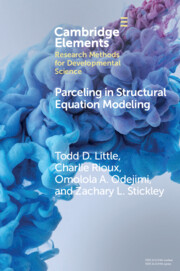Crossref Citations
This Element has been
cited by the following publications. This list is generated based on data provided by Crossref.
Little, Todd D.
Rioux, Charlie
Odejimi, Omolola A.
and
Stickley, Zachary L.
2022.
Parceling in Structural Equation Modeling.
Ben-Shalom, Uzi
Reizer, Abira
Connelly, Vincent
and
Rickover, Itamar
2023.
The adaptation of soldiers to post-service life – the mediating impact of political views on the relationship between violence and adaptation.
Frontiers in Psychology,
Vol. 14,
Issue. ,
Gordon, Rachel A.
Wang, Tianxiu
Nguyen, Hai
and
Aloe, Ariel M.
2023.
Identifying and Minimizing Measurement Invariance among Intersectional Groups.
Hogye, Sara I.
Lucassen, Nicole
Helmerhorst, Katrien O. W.
Vrolijk, Paula
Keizer, Renske
and
Zabrodskaja, Anastassia
2023.
Changes in coercive parenting and child externalizing behavior across COVID-19 and the moderating role of parent-child attachment relationship quality.
PLOS ONE,
Vol. 18,
Issue. 10,
p.
e0290089.
Televantou, Ioulia
Marsh, Herbert W.
Xu, Kate M.
Guo, Jiesi
and
Dicke, Theresa
2023.
Peer Spillover and Big-Fish-Little-Pond Effects with SIMS80: Revisiting a Historical Database Through the Lens of a Modern Methodological Perspective.
Educational Psychology Review,
Vol. 35,
Issue. 4,
Petitta, Laura
and
Ghezzi, Valerio
2023.
Remote, Disconnected, or Detached? Examining the Effects of Psychological Disconnectedness and Cynicism on Employee Performance, Wellbeing, and Work–Family Interface.
International Journal of Environmental Research and Public Health,
Vol. 20,
Issue. 13,
p.
6318.
Popham, Cassandra M.
McEwen, Fiona S.
Karam, Elie
and
Pluess, Michael
2024.
The important role of mothers during displacement: Direct and indirect effects of the refugee context on Syrian refugee children's mental health.
Child Development,
Vol. 95,
Issue. 3,
Karaca-Atik, Ayşegül
Gorgievski, Marjan J.
Meeuwisse, Marieke
and
Smeets, Guus
2024.
Possessing 21st-Century Skills and Building Sustainable Careers: Early-Career Social Sciences Graduates’ Perspectives.
Sustainability,
Vol. 16,
Issue. 8,
p.
3409.
Balkundi, Swapna
and
Fredrick, Stephanie S.
2024.
Students’ Perceptions of COVID-19 Stress and Internalizing Problems: Is Social Support a Buffer?.
Contemporary School Psychology,
Vol. 28,
Issue. 1,
p.
3.
Spiteri, Jane
2024.
Children's Voices and Agency.
Rahm, Tobias
Oberlehberg, Nicole
and
Mayer, Axel
2024.
Teaching happiness to students – implementation and evaluation of a program aiming at promoting wellbeing in elementary schools.
Frontiers in Psychology,
Vol. 15,
Issue. ,
Diamanti, Vassiliki
Grande, Germán
Protopapas, Athanassios
Melby-Lervåg, Monica
and
Lervåg, Arne
2024.
Preschool Morphological Awareness and Developmental Change in Early Reading Ability.
Scientific Studies of Reading,
Vol. 28,
Issue. 6,
p.
591.
Cole, Veronica
and
Lacey, Conor H.
2024.
Algorithms for Measurement Invariance Testing.
Hess, Sophia
Wahl, Andreas
and
Johnson, Alan R.
2025.
Measuring entrepreneurial ecosystems across levels: a district approach.
Small Business Economics,
Vol. 65,
Issue. 3,
p.
1617.
Petitta, Laura
Jiang, Lixin
and
Ghezzi, Valerio
2025.
Contextual Emotions in Organizations: A Latent Profile Analysis of Their Co-Occurrence and Their Effects on Employee Well-Being.
European Journal of Investigation in Health, Psychology and Education,
Vol. 15,
Issue. 7,
p.
122.
Saez-Zevallos, Nataly Susan
Cunza-Aranzábal, Denis Frank
Abanto-Ramírez, Carlos D.
and
Montalvo-Apolín, Danitza Elfi
2025.
Relationship between English self-efficacy and language learning strategies among Peruvian university students: the mediating role of academic self-efficacy.
Frontiers in Education,
Vol. 10,
Issue. ,
Wray-Lake, Laura
Hope, Elan C.
Saavedra, J. Abigail
Arce, M. Alejandra
and
Conner, Jerusha O.
2025.
Youth activism: developing sociopolitical synergy across interest, knowledge, and involvement.
Applied Developmental Science,
p.
1.
Iselin, Anne-Marie R.
DeCoster, Jamie
DiGiunta, Laura
Lansford, Jennifer E.
Dodge, Kenneth A.
Eisenberg, Nancy
Pastorelli, Concetta
Tirado, Liliana Maria Uribe
and
Bacchini, Dario
2025.
Rumination Mediates the Relation of Hostile Attribution to Psychological Maladjustment Among Adolescents from Three Countries.
Research on Child and Adolescent Psychopathology,
Vol. 53,
Issue. 6,
p.
861.
Bayram, Yunus
2025.
The Relationship of Determinism, Free Will and Randomness Beliefs with Authenticity and the Mediating Role of Life Meanings among Young Adults in Türkiye: An Existential Social Work Perspective in Clinical Social Work.
Clinical Social Work Journal,
Vol. 53,
Issue. 4,
p.
479.
Bayram, Yunus
2025.
From ‘Know thyself!’ to ‘Be your true self’: free will belief as a mediator in the relationship between internal state awareness, appearance consciousness, style consciousness, and social anxiety with authenticity.
Current Psychology,
Vol. 44,
Issue. 6,
p.
4791.

 Loading metrics...
Loading metrics...


